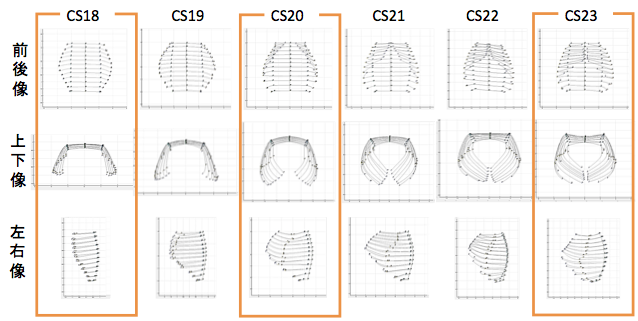奥野さんの卒業論文がAnatomical Recordに掲載されました。
胚子期の位相CTを用いて、肋骨、脊椎上に座標を84点/標本とり、胸郭の形成の特徴を定量的に示しました。

- CS17 に肋骨の軟骨形成が検出可能、胸腹部の背側から外側に拡大
- 肋骨は、胸部を取り囲むように伸び、CS20 に上部と下部の胸郭領域に分化
- 上部領域の対応する肋骨の端は、CS21 -CS23 の間に結合し胸骨形成する。
- 最大幅の胸郭領域は、CS17 の 5 番目の肋骨対から CS23 の 9 番目の肋骨対に移動
- 最大幅の位置に肝臓あり、最大深さの部位に心臓あり
Okuno K, Ishizu K, Matsubayashi J, Fujii S, Sakamoto R, Ishikawa A, Yamada S, Yoneyama A, Takakuwa T. Rib cage morphogenesis in the human embryo: A detailed three-dimensional analysis. Anat Rec 2019, 302, 2211-2223, doi: 10.1002/ar.24226
ABSTRACT
Formation of the skeletal structure in the human embryo has important consequences in terms of support, protection, and function of organs and other systems. We aimed to describe the formation of the rib cage during the embryonic period, in order to detect prominent features and identify the possible factors affecting rib cage morphology. We employed high-resolution digitized imaging data (n = 34) obtained in human embryos with Carnegie stage (CS) between 17 and 23. The rib cage became detectable as cartilage formation at CS17, expanding outward from the dorsal side of the chest-abdominal region. Ribs elongated progressively to surround the chest, differentiating into the upper and lower rib cage regions by CS20. The ends of corresponding ribs in the upper region elongated toward each other, leading to their joining and sternum formation between CS21 and CS23, while the lower region of the rib cage remained widely open. The rib cage area with the largest width shifted from the 5th rib pair at CS17 to the 9th pair at CS23. The depth of the rib cage was similar across the upper region at CS17, with the major portion remaining in the middle part after CS20. The heart was located beneath the rib pairs providing the largest depth, while the liver was located beneath the rib pairs providing the largest width. Formation of the sternum, development of spinal kyphosis, and organization of larger internal organs within the thoracic and abdominal cavity are possible factors affecting rib cage morphology. Anat Rec, 302:2211–2223, 2019.







